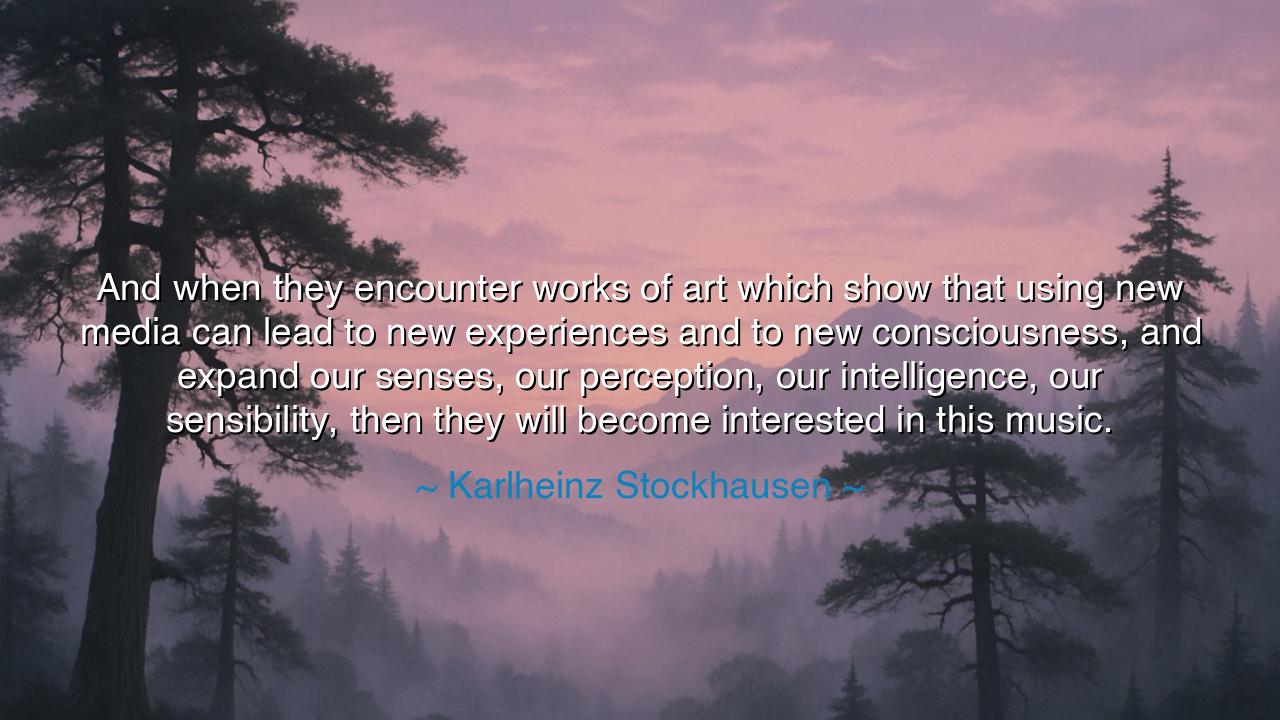
And when they encounter works of art which show that using new
And when they encounter works of art which show that using new media can lead to new experiences and to new consciousness, and expand our senses, our perception, our intelligence, our sensibility, then they will become interested in this music.






“And when they encounter works of art which show that using new media can lead to new experiences and to new consciousness, and expand our senses, our perception, our intelligence, our sensibility, then they will become interested in this music.” – Karlheinz Stockhausen
These words, spoken by Karlheinz Stockhausen, one of the boldest pioneers of modern music, resound like a prophecy for every age of transformation. He, who stood at the frontier between sound and silence, between science and spirit, saw art not as entertainment, but as a gateway to new consciousness. When he speaks of “new media” and their power to “expand our senses, our perception, our intelligence, our sensibility,” he calls upon humankind to awaken — to recognize that the evolution of art is bound to the evolution of the human soul. Stockhausen believed that each new tool, each new instrument, each new medium of creation carries within it the possibility of expanding what it means to be alive, to feel, and to understand.
To grasp the depth of this teaching, we must look to the spirit of his time. Stockhausen lived through the great upheavals of the twentieth century — a century of electricity, machinery, and cosmic exploration. In the ruins of war, he saw not destruction alone, but the birth of a new world of sound. He was among the first to weave electronic tones and recorded noises into the sacred fabric of music, defying the traditions that confined harmony to strings, breath, and wood. For him, the synthesizer was not a machine, but a vessel of consciousness — a means through which the human mind could project itself into uncharted realms of experience. He believed that through sound, man could expand perception itself, hearing not merely with the ear, but with the spirit.
To the uninitiated, his music seemed strange — a chaos of frequencies, a storm of alien tones. Yet those who listened deeply discovered what Stockhausen meant: that art, when freed from convention, can awaken new ways of being. Just as ancient man once saw fire as a miracle, so the modern man, when faced with new forms of art, must learn again to marvel, to listen, to feel without prejudice. “They will become interested in this music,” he says, not through persuasion, but through revelation — when they recognize in it a mirror of their own evolving consciousness. His words remind us that the purpose of art is not comfort, but transformation; not imitation of life, but the expansion of life’s boundaries.
Think of the painter Wassily Kandinsky, who, like Stockhausen, sought to move beyond the familiar senses. He cast aside the visible world and painted inner soundscapes, claiming that color itself was a vibration of the soul. When critics scoffed at his abstractions, he answered that the artist’s task is not to decorate, but to elevate consciousness — to reveal the invisible through the visible. In the same spirit, Stockhausen believed that music could dissolve the borders between sound and silence, earth and cosmos, self and infinity. He dreamed of concerts that would not merely entertain, but awaken — that would transform the listener from a consumer of sound into a participant in the universe’s living harmony.
At its heart, Stockhausen’s philosophy speaks to a greater truth: that art is evolution made audible. Every new medium — from the printing press to the digital screen, from the drum to the synthesizer — is a step in humanity’s dialogue with creation. Each discovery challenges us to expand our sensibility, to see, hear, and feel the world anew. But this evolution requires courage — the courage to let go of what is familiar, to embrace the strange, to recognize that progress in art is not a betrayal of the past, but its continuation at a higher level of awareness. Those who cling only to what they understand close the door to wonder; those who listen with open hearts become the heirs of the future.
Yet, there is wisdom here beyond music. For Stockhausen’s words apply to all realms of human endeavor. Every generation encounters new “media” — new technologies, new philosophies, new ways of seeing. The question is whether we will use them to expand our intelligence and sensibility, or to dull them. Will we let innovation awaken consciousness, or enslave it to distraction? The answer lies in our attitude: whether we approach creation as artists or as consumers, as seekers or as spectators. To become truly “interested in this music” — in the grand symphony of human progress — we must first learn to listen, not only with the ear, but with the soul.
So let this be the teaching: embrace the new, but seek the eternal within it. Do not fear unfamiliar art, technology, or thought, for these are but new languages through which truth speaks. When you encounter something strange, ask not “What is this?” but “What can this awaken in me?” For the world is ever creating itself anew, and the wise man walks in rhythm with that creation. As Stockhausen foresaw, the future belongs not to those who cling to old forms, but to those who dare to hear the music that no one else has yet heard — the music of new consciousness, born from the marriage of human spirit and infinite possibility.






AAdministratorAdministrator
Welcome, honored guests. Please leave a comment, we will respond soon